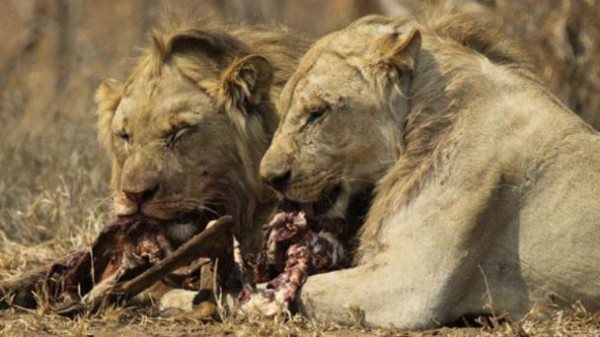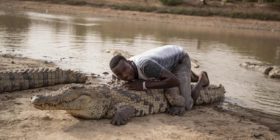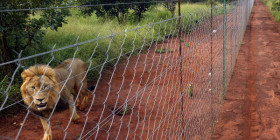Despite its high density of leopards, Malawi could previously only lay claim to a few itinerant lions in southerly Liwonde National Park. The solitary male, known as Titus, was as elusive as the literary character after which he was named; spotted in 2007 he went to ground until 2010, only to be seen once more before disappearing in 2011. Not much of a reason for big cat buffs or travellers keen on spotting the precious Big Five (lion, rhino, buffalo, leopard, elephant) to set their compass for this southern African country.
Fortunately, late last August, two females and two male lions (all three years old) were translocated from South Africa to Malawi’s Majete Wildlife Reserve in the south of the country. Along with a new president, former women’s rights activist, Dr Joyce Banda (sworn in April 2012), the lions represent a symbolic new start for this under-the-radar African nation.
To give both arrivals some context, things in the country – known as the “Warm Heart of Africa” (both for its geographical location and the friendly nature of its people) – had been going from bad to worse under Malawi’s despotic president Bingu Wu Mutharika (2004 to 2012). By early 2012, the country was in the grip of a debilitating fuel crisis, its economy battered by Mutharika’s insistence on inflating the kwacha (national currency) by 40%. To compound this, foreign exchange had been banned by the president and the British High Commissioner kicked out. For travellers, there was no point in visiting; it was impossible to get around without fuel and far too expensive.
But as the lions were being selected, Banda was putting the country back together, re-establishing £93 million in aid from Britain, solving the fuel crisis and making her presence known to the likes of US President Obama and the International Monetary Fund. And then late summer, as the economic skies began to clear for the first time in years, the lions arrived at Majete, heralding a fresh dawn.
While lions are social creatures who live in prides, they cannot be simply thrown together in the hope they will get along. Cohesion occurs only when they come from the same area, so the Majete lions were carefully picked and tranquilized in South Africa, and slowly introduced to one another in a boma (enclosure) for a month before making their great journey by plane to Majete. Sadly one female died of hypertension on the flight – a major blow to an operation that had been years in the planning – making it all the more crucial for the lions to adapt successfully to their new environment.
Over the last nine months the lions have begun marking their territory in northeastern sector of the reserve. Very soon after their arrival, to the relief of African Parks’ staff, they began hunting together and made several kills, including reedbuck, warthog and zebra. More importantly one of the two males, Chimwala (meaning big rock), has taken to the dominant female, Shire (named after the famous river that explorer David Livingstone navigated into Lake Malawi in 1859), and they have started to mate – much quicker than was expected.
Given their status as apex predators, other animals in the park have had to recalibrate their behaviour accordingly, as have the rangers who take visitors on walking safaris. Since the lions are tagged, they can be successfully avoided on foot and easily discovered by car.
About 70km southwest of Blantyre, Malawi’s commercial capital, and a short hop from Liwonde National Park, Majete is one of the country’s largest protected areas, occupying 7,000 hectares of land. Like Malawi itself, it too has struggled to survive; prior to African Parks taking over management of the reserve in 2003 (in partnership with the government), the park’s animals had been hunted close to extinction, and the unfenced area was being encroached on by human cultivation. The introduction of lions is the crowning lorry to an expensive, nine-year process of massive reinvigoration, where Majete became restocked with some 3,000 animals such as leopard, bushbuck deer, rhino, gazelle, elephant, buffalo; its entire perimeter was electric-fenced; and 150km of roads were laid to make the reserve more safari-friendly.
In addition, an impressive new lodge was established in 2012 by esteemed safari providers Robin Pope Safaris. Mkulumadzi Camp, accessed across a wobbly riverine suspension bridge, is now one of the most beautiful places to stay and spot wildlife in the whole country; be it crocodile, buffalo, leopard, elephant or lion. Its luxury accommodation is nothing short of sumptuous; situated at the confluence of the Mkulumadzi and Shire Rivers, the central building houses a fire pit, a kidney-shaped swimming pool, driftwood sculptures and eight grass-roof eco chalets that blend perfectly with their surroundings, with rain showers, sunken baths and widescreen views of the river.
The game drives – be it day, night or river safari – take the visitor past fleeting bushbucks, their backsides painted with distinctive white rings, and bad tempered African water buffalo, one of Africa’s most dangerous animals. There is also a staggering number of elephants; come dusk you can expect to find your path blocked by herds making for an evening drink. Young bulls are prone to charge in an act of dust kicking and testosterone, but the guides are expert at talking to them quietly and slowly drawing away.
It is hoped that Liwonde National Park and northerly Nyika National Park will soon follow suit with lion reintroduction, but for the moment all eyes are fixed on the pride in Majete, waiting patiently for the first birth – and with it perhaps the hopes of a nation.






Leave a reply